
This paper would brief some of the important services that NWDAF provides the NF consumers for getting the analytics information. This paper also includes a high level of information on how NWDAF collects the data from NFs for analytics purposes. This paper shall not explain how the data is used by NWDAF to form the analytics O/P to the NFs.
1. Introduction
Data analytics in simple terms refers to the analysis of data. The process involves continuous extraction of data, analyzing the extracted information and forming a behavioral pattern. The analysed information helps to improve the network/system performance, capacity and availability. The process can vary from Business-to-Business based on the requirements.
With the evolution of telecommunication and introduction of millions of devices to the network in 5G, data analytics is going to play a key role. It becomes mandatory for the Telecom operators (Communication Service Providers) to use analytics as the main function that can collect, analyze and make real-time decisions by itself in order to provide better service to the service consumers (E.g.: eMBB, IoT devices, etc.,).
Analysis of network data is not new to 5G. Earlier telecommunication technology also involved manual analysis of network data. The KPI’s of individual network nodes are frequently collected and the analysis of that data was done by the operators. The outcome of the analyzed data results either in an enhancement decision for future (or) push operators to take reactive decisions to resolve the outages temporarily. These reactive decisions only bring limited advantage to the network elements for a period of time. The solution to satisfy the end consumer also happened only over a period. Hence the analytics function (NWDAF) in 5G is considered as an important entity that can perform automatic analysis of collected data and provide decision making information to the NFs.
2. Significance of the Analytics node
With the evolution of AI it becomes important to introduce a new entity in the telecommunication network that can learn, improve and form data patterns by itself based on experience and collected data. 3GPP has come up with a new entity called NWDAF in 5G. NWDAF with machine learning capability collects network specific datas from NFs and provides real time analyzed info back to NFs. NWDAF shall also make predictive analysis that helps to proactively manage the 5GS with less human effort.
In a heterogeneous environment like 5G, it becomes important for each function to continuously evolve and provide better services to the end consumers. This can be achieved only if the functions in 5G core act proactively and take real time decisions which in turn can provide the necessary services to the 5G consumers without any delays.The NWDAF becomes a central point for analytics in the 5G network. It uses Nnwdaf services to provide the analyzed information to the consumer nodes.
With a huge number of end devices like mobile, drones, IoT applications etc., connected to the 5G network it looks evident that each function involved in the 5G systems must evolve itself and take real time decisions by making use of the data analytic function.
3. Notification Events
NWDAF shall notify the following events to NF consumers upon subscription.
- Load level information of Network slice instances. (NSSF)
- NFs Load analytic information (AMF and SMF)
- Service Experience.
- QoS sustainability. (PCF)
- UE mobility and UE communication. (NEF will collect and forwards to AF)
- User Data congestion (NEF will collect and forwards to AF)
- Abnormal behavior. (OAM)
4. Services offered
As per 3GPP TS 29.520 Release 16, Figure 1 and 2 illustrates the different consumer nodes of NWDAF services. NWDAF provides different analytic information to NFs based on analyzed events.
Two type of services offered to consumers by NWDAF:
- Nnwdaf_EventsSubscription
- Nnwdaf_AnalyticsInfo


Figure 2: NFs using Nnwdaf Analytic info services
4.1. Nnwdaf_EventsSubscription
In order to make use of the service, the consumer nodes have to get registered with the NWDAF through the Subscribe/Unsubscribe method. Once the subscription is done the NWDAF will store the subscription and notify the consumers about observed events using Notify method. The NWDAF supports this service on RESTFUL API that uses HTTP/2 version.
4.1.1. Operations supported


Figure 4: Subscription using PUT method


The NWDAF will invoke a HTTP POST request to notify the consumer about the observed event. Once the notification from NWDAF is accepted by the NF (Consumer node) it will store the notification for further processing and will respond with a “204 No Content” to NWDAF.
4.2. Nnwdaf_AnalyticsInfo Service
The consumer nodes that can use the service are mentioned in Figure 2. NWDAF allows consumer nodes to request and get the different types of analytical information whenever required. HTTP GET request is invoked towards the NWDAF for getting the analytic information.
4.2.1. Operation Supported

NWDAF will analyse the requested analytical data according to the requested event. If NWDAF accepts the GET query then it will respond with the “200 OK” along with a message body that has the analysed information requested by the NF consumer. If the data is not present in the NWDAF it will respond with “204 No content”.
5. Data collection for Analytics
The Data collection feature in NWDAF helps in retrieving data from the NFs for the computation of network analytics. When a subscription request for analytics is received, NWDAF may not have the necessary data to provide the service to the NF consumer immediately. NWDAF may return a probability assertion with confidence level of analytics. With Zero confidence level no analytics will be provided to the NFs. The level of confidence will grow in case of subscription. Data collection procedure enables the NWDAF to retrieve appropriate data and perform the analytics. If a greater number of repetitive data are shared with NWDAF for analysis, then it will complicate the processing of the analytic function. So, NWDAF can skip the data collection if the data is already present for the requested analytics. This can significantly increase the performance of the NWDAF to form a behavioral pattern in a short time.
NWDAF can make use of the exposure services offered by NFs to retrieve NF data. NWDAF can also retrieve data from OAM for global NF data. NWDAF shall invoke the event exposure service using a subscription method and get notified by the NFs with the requested data for analytics. A light weight process “Data Exporter” in the NFs may provide the required data. No other analytics will be performed by this “Data-Exporter” module in NFs. The reason for not providing the analytic capability is to ensure that each function works in fulfilling its primary objective and not carried away with this processing activity.
The processed data will be sent to the NWDAF where it gets stored in its “Data Repository” area. The “Analyzer” inside the NWDAF will use its own algorithm to collect data from the repo for analysis and to form a behavioral pattern. The Processed data will be provided to the NFs using the Nnwdaf offered Service.
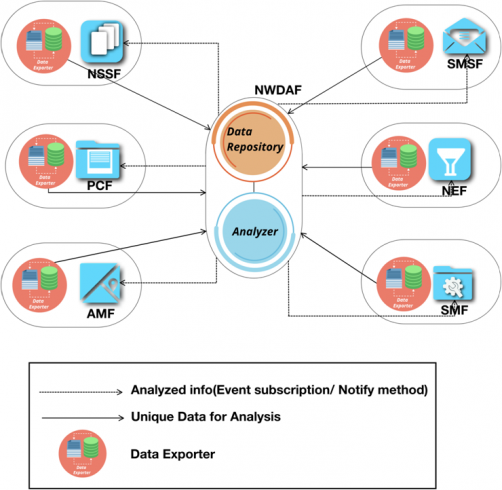
Figure 8: Information flow between Data Exporter, NWDAF and NFs
6. Use cases
Below are a few use cases that describe how certain NFs in the 5GC use the NWDAF analysed data in order to improve the overall performance of 5GS and provide better services to the end users.
6.1. Automatic Policy control using NWDAF
PCF in 5G is considered as a key consumer of NWDAF information in 5GC. PCF is the same as PCRF in the 4G network.
Consider the below picture where the user connected to the data network uses different services that require normal to very high speed data. The SMF in the 5GC acts as a key provider of data usage related information to the NWDAF. The information may include maximum data used per session and data usage per user at different times of the day. With that information the NWDAF would be able to form a data usage pattern for a user. PCF will be having multiple rules with different QoS, bandwidth, uplink and download speed configured to serve different purposes. With NWDAF input, PCF will enforce specific rules appropriately for the user according to the usage pattern. This type of proactive decisions by PCF also helps in utilizing the 5G resources appropriately.
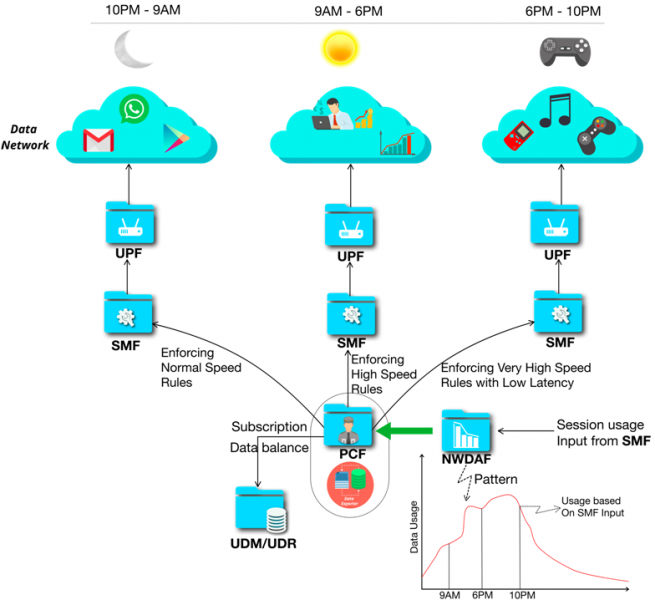
Figure 9: NWDAF use case to Optimize data usage at different times for a user
6.2. Automatic Network Slice Selection using NWDAF
Network slicing is a key feature that was introduced in the 5GS. It becomes important for the NSSF to select a slice based on the service type and usage. The service may include eMBB, IoT, mission critical emergency services etc. In 5G core, the NSSF also acts as a Key consumer of NWDAF analytic data. The NSSF collects the load level information of the particular slice from the NWDAF and allocates the user with a different slice from the 5G core if required.
Consider a National day celebration where a huge number of people gather to witness and celebrate the might of the nation. Network operators face a big challenge to provide seamless services to its customers. NSSF in 5G provides a huge advantage to overcome these challenges by using the NWDAF analytical data.
NWDAF got the slice load level information from the NSSF Exporter and made it available in its Data repository. Based on the day to day analysis and history of data the NWDAF predicted a behavioral pattern which indicates the expected utilization might get spiked to a certain level during the National day . Based on the NWDAF inputs, NSSF prepares itself to automatically allocate the next available slice in the core network to achieve all the services like eMBB for its users, URLLC for medical emergencies and other mission critical military emergency services (E.g., Drones).
The below pictures describe the allocation of slices by NSSF based on the slice load level information received from NWDAF. Consider figure 10 “Embb” service usage on a normal day. With 30% utilization only one slice is sufficient to provide good service to the user. Whereas during a festival/national day (figure 11) the usage of Embb service has almost doubled. Based on NWDAF predictive analysis the NSSF was able to allocate a new slice with load sharing for “Embb” even before the overload started to happen over the 1st slice that was serving Embb.
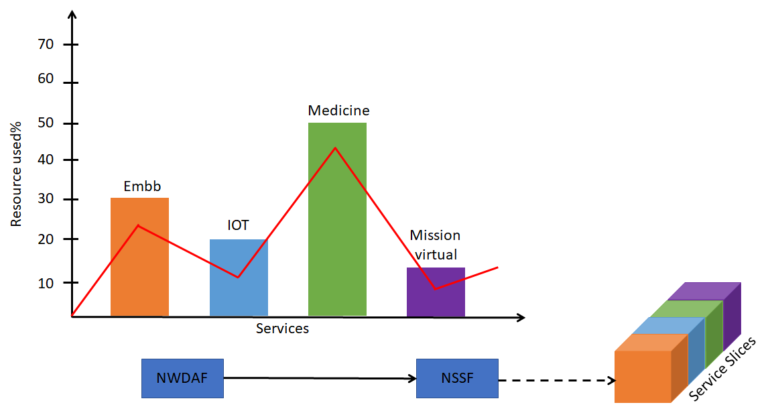
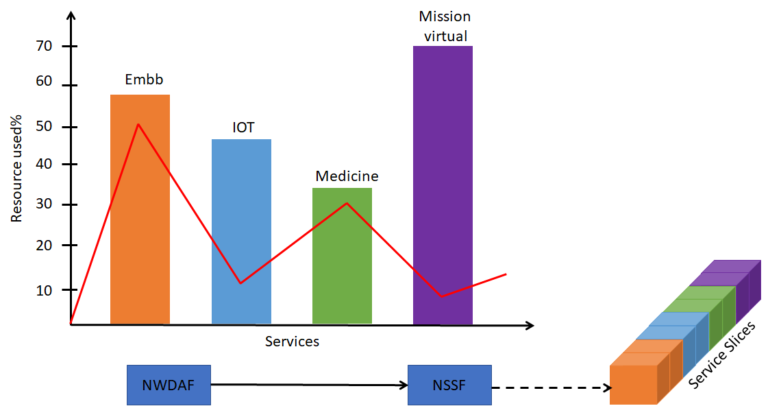
6.3. Automatic access and mobility using NWDAF
Access and Mobility management function (AMF) in the 5G system acts as a key gateway point to the 5G core network. It handles the registration of users and monitors the mobility of the 5G connected device. Also, act as an authenticating and authorizing unit for communication within the NFs in the 5G core. It establishes its connection to User Equipment through NAS signaling. NWDAF analytic information can help the AMF to assign RAN’s and make real time decisions during mobility.
Consider a user attached to the 5G network travelling in a car. Since 5G is having shorter wavelengths, there comes a situation where users must move from one cell to the other in a shorter time which increases the handover operation considerably. Because of frequent handover the user service usage will drop and his mobile battery will drain at a faster pace.
In earlier days these decisions were taken reactively by the network during user mobility (e.g., frequent change in the network 2G/3G/4G during travel). With the use of NWDAF information this challenge can be overcomed if the AMF has the capability to take proactive decisions and provide a suitable RAN for the user throughout his mobility.
The “Data-Exporter” in the AMF will frequently collect information such as Visited locations, SIM info, RAN network and other RF parameters etc., These data are fed to the NWDAF which stores them in a “Data Repository” for analysis. The analytics in the NWDAF is able to form a behavioral pattern based on the user’s mobility and the usage. The information is conveyed to the AMF based on which it will allocate the user with the best RAN during his mobility. This type of proactive automatic decision made by AMF benefits the user hugely (Eg., UE battery saved, better service usage because of low handovers). It also helps the 5GC to free up some resources for other users who might require a 5G speed service.
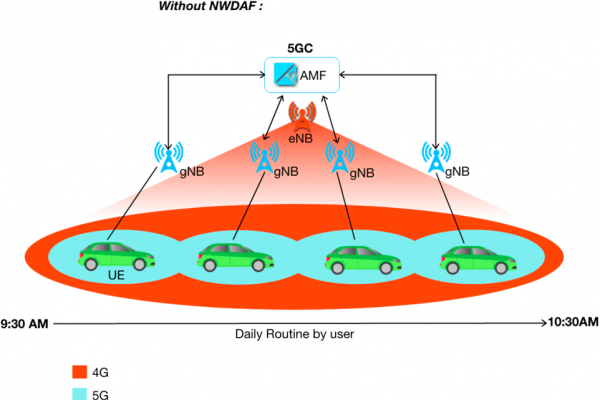
Figure 12: Without NWDAF – UE using 5G RAN with frequent handovers
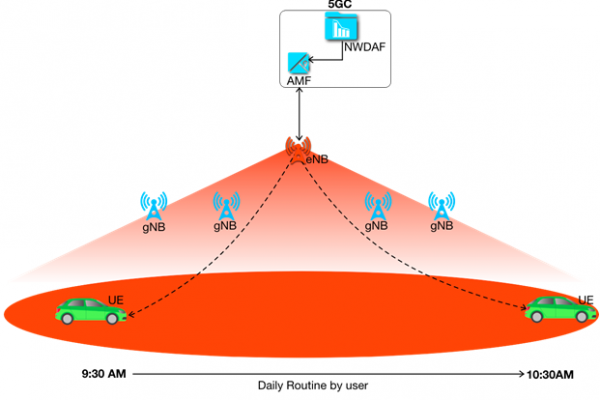
Figure 13: With NWDAF – UE using 4G RAN resulting less handovers
6.4. Throttling Promotional messages (SMSs) using NWDAF
The promotional messages are similar to a kind of advertisement strategy used by operators. Until the 4G era, the operator’s depended on sending promotional messages for introducing new products, benefits and features to the end subscribers. This promotional message is triggered manually/scheduled through certain bulk SMS tools during the low traffic hours(12 AM to 6AM). With the evolution of 5G, it becomes important for operators to send certain types of informative messages also in bulk towards the IoT devices, subscribers etc., apart from only sending the promotional messages.
With millions of devices connected to the 5G network it becomes a real challenge for the operators to decide and trigger messages during low traffic hours manually. The devices may be either a mobile user, IoT devices etc., With the help of NWDAF in 5G, this challenge can be overcome easily. NWDAF is already having all the slice and load level information from network function in the 5G core and could easily form a behavioral pattern. It could give enough information about the peak traffic and low traffic time in the network. Based on the information from NWDAF about SMSF load, the bulk message can be triggered whenever required in a controlled manner throughout the day. Message throttling can also be done by Bulk SMS tool whenever required based on the usage pattern received from the NWDAF.

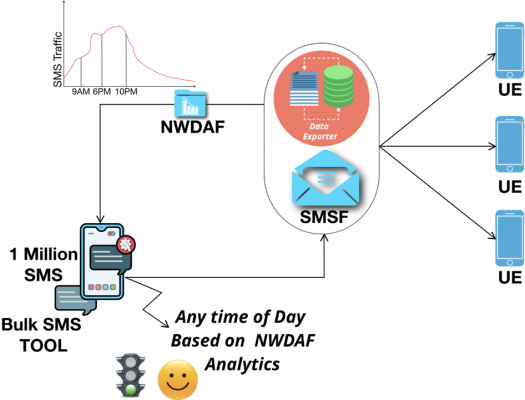
6.5. Infrastructure scaling using NWDAF
NWDAF apart from serving the 5G network functions also helps the operators to plan their enhancement in infrastructure based on resource utilization. This is useful because, based on the data provided by the NWDAF the NFs can make real time decisions for allocating the resources but are limited to a certain extent (based on hardware resources available).
Consider the 5GC that is deployed for a new operator with a certain resource requirement. It was believed by the operator that the existing hardware resource is more than enough for the next couple of years. Post the GO-Live, things changed, and the traffic seems to continuously grow in a rapid phase. NWDAF performed the analysis on the slice load over a period from NSSF and was able to form a behavioral pattern. The pattern clearly indicates the resource utilization in the core is becoming higher day-by-day and indicates the resource might get utilized even before the expected date. This type of forecast analysis by the NWDAF clearly helps the team to pre-plan the infrastructure enhancement thereby to avoid any overload on the network nodes which leads to a service impacting situation.
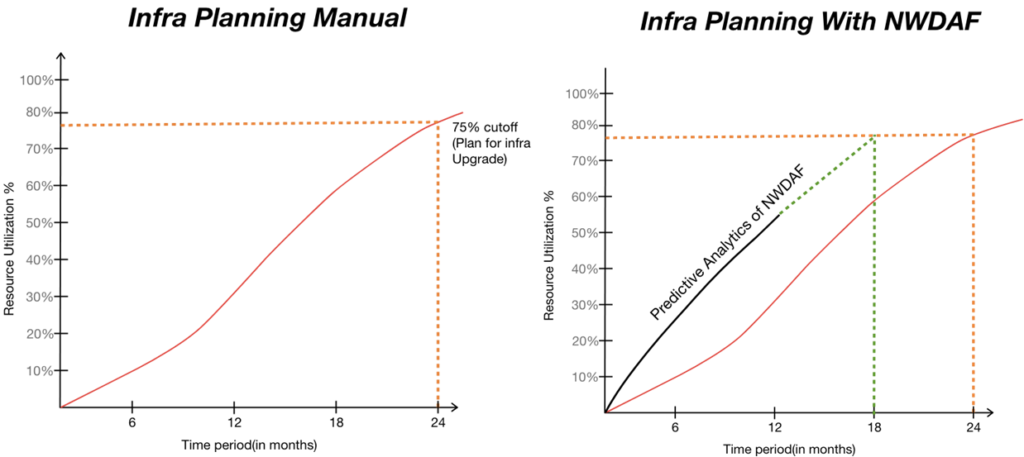
Figure 16: Infrastructure utilization efficiently predicted with NWDAF
7. Conclusion
The advantage and benefits provided by the NWDAF in the 5G system can be witnessed by the operator’s and the end users over a period of time. The proactive analysis done by the NWDAF helps the operators to focus more on adding better and new services to the end users rather than involving them in taking reactive decisions during network outages. It also helps the infrastructure team to carefully analyse the resource usage pattern and come up with better infrastructure upgrade plans/solutions.



